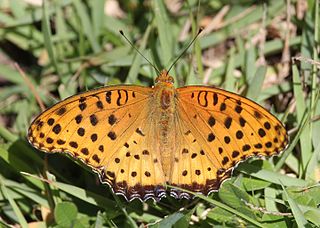Related Research Articles

Jamides celeno, the common cerulean, is a small butterfly found in Indomalayan realm belonging to the lycaenids or blues family. The species was first described by Pieter Cramer in 1775.

Prosotas nora, the common lineblue, is a species of lycaenid butterfly found in Asia to Australia. The species was first described by Rudolf Felder in 1860.

Nacaduba hermus, the pale four-line blue, is a species of lycaenid butterfly found in Indomalayan realm. The species was first described by Baron Cajetan von Felder in 1860.

Vindula erota, the common cruiser, is a species of nymphalid butterfly found in forested areas of tropical South Asia and Southeast Asia.

The Indian fritillary is a species of butterfly of the nymphalid or brush-footed family. It is usually found from south and southeast Asia to Australia.
Ionolyce helicon, the pointed lineblue, or bronze lineblue, is a small butterfly found in the Indomalayan realm that belongs to the lycaenids or blues family.
Acrapex brunnea is a species of moth of the family Noctuidae first described by George Hampson in 1910. It is found in Africa, including Angola, Kenya and South Africa.
Metathrinca tsugensis is a moth of the family Xyloryctidae. It is native to Japan, but is an introduced species in western Europe and Hawaii.
Phostria cleodalis is a moth in the family Crambidae. It was described by William Schaus in 1920. It is found in Bolivia.
Polygrammodes herminealis is a moth in the family Crambidae. It was described by Schaus in 1920. It is found in Brazil (Paraná).
Polygrammodes dubialis is a moth in the family Crambidae. It was described by Schaus in 1924. It is found in Brazil.
Samea choristalis is a moth in the family Crambidae. It was described by George Hampson in 1912. It is found in Trinidad.
Sinomphisa junctilinealis is a moth in the family Crambidae. It is found in Sierra Leone and Uganda.
Steniodes dominicalis is a moth in the family Crambidae. It was described by Schaus in 1924. It is found on Dominica.
Syllepte methyalinalis is a moth in the family Crambidae. It was described by George Hampson in 1912. It is found in Guyana.
Syllepte anchuralis is a moth in the family Crambidae. It was described by William Schaus in 1920. It is found in Guatemala.
Udea endotrichialis is a moth in the family Crambidae. It was described by George Hampson in 1918. It is found in Taiwan.
Udea melanephra is a moth in the family Crambidae. It was described by George Hampson in 1913. It is found in Colombia and Bolivia.
Udea poasalis is a moth in the family Crambidae. It was described by Schaus in 1912. It is found in Costa Rica.
Ulopeza sterictodes is a moth in the family Crambidae. It was described by George Hampson in 1912. It is found in Papua New Guinea.
References
- ↑ "global Pyraloidea database". Globiz.pyraloidea.org. Retrieved 2014-07-15.
- ↑ Proceedings of the Entomological Society of Washington
| This Margaroniini-related article is a stub. You can help Wikipedia by expanding it. |